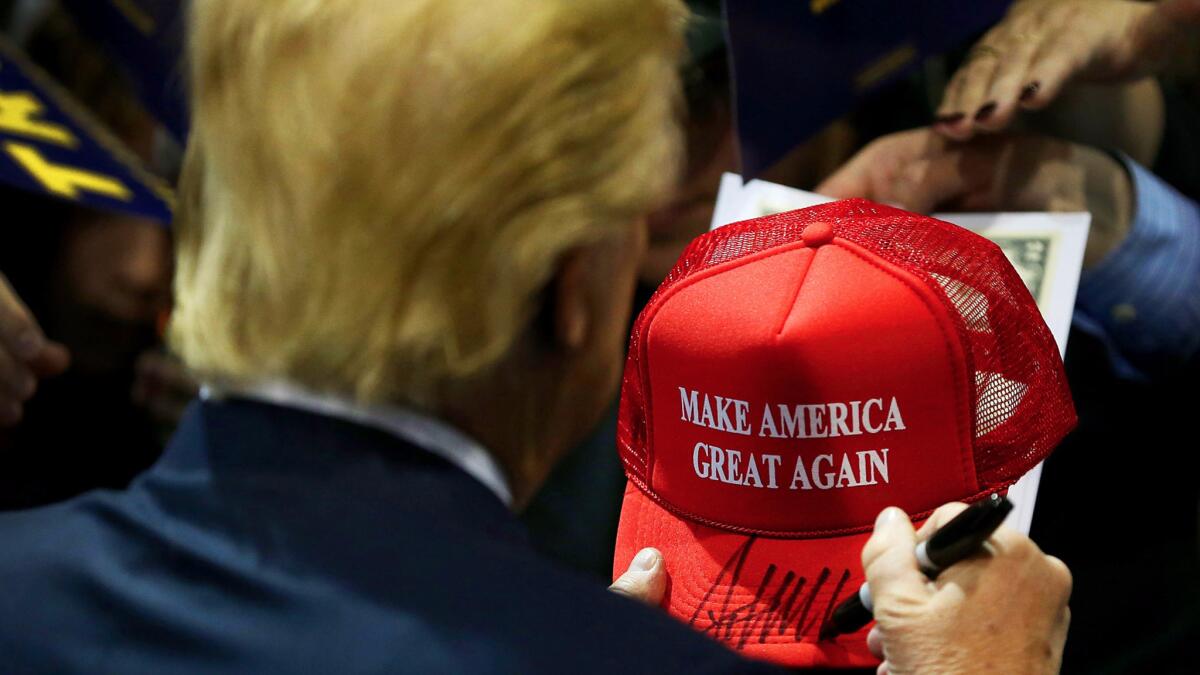San Francisco chef bans MAGA caps at restaurant — then apologizes for it

- Share via
Nearly a week ago, Bay Area Chef J. Kenji Lopez-Alt, co-owner of Wursthall, logged on to Twitter and sent a fluttering message:
“It hasn’t happened yet, but if you come to my restaurant wearing a MAGA cap, you aren’t getting served,” he tweeted Sunday. “Same as if you come in wearing a swastika, white hood, or any other symbol of intolerance and hate.”
He followed that tweet with another controversial one:
“MAGA hats are like white hoods except stupider because you can see exactly who is wearing them,” he wrote.
The tweets sparked a national debate about a business refusing to serve people because of their political beliefs and what “Make America Great Again” caps have come to symbolize amid a divisive political climate.
In a statement released Friday, Lopez-Alt apologized to his staff and customers over the comments and explained that he was reacting to a growing trend of hateful and violent acts involving people with red MAGA caps.
“My message was intended to reject anger, hate and violence, and indicate that these shouldn’t be welcomed in our society and aren’t welcome in our community,” he wrote. “It was aimed at these three elements rather than at a physical object, but I understand that many interpreted my words in a different context and construed a message of hate directed at them. This was not my intent in any way, and I am sorry for my recklessness.”
He said everyone was welcomed at the restaurant — so long as they leave their hate, anger and violence at the front door.
Days before Lopez-Alt’s tweets, activist and celebrity Alyssa Milano had tweeted and called the red MAGA hats the “new white hood.”
The red ballcaps were part of President Trump’s campaign more than two years ago but have since become a hot-button issue.
Critics say that the hats connote more than a political disagreement and that they represent hate and racism. Opponents point to a series of violent attacks in which the perpetrators have worn the red hats.
Last February, video of Nikolas Cruz, the suspect in the mass shooting at a Parkland, Fla., high school, surfaced, showing him standing in his backyard, holding a gun and wearing a MAGA hat.
Last April, prosecutors in New York alleged that Willie Ames, 47, punched a Mexican immigrant and pushed him onto the Union Square subway tracks. Ames had made racist remarks before attacking the victim, authorities said, adding that he was wearing a red MAGA hat.
Most recently, “Empire” star Jussie Smollet, an openly gay black actor, said he was brutally attacked by two white men who put a noose around his neck and screamed, “This is MAGA country.”
Chicago police are investigating the case as a hate crime.
Lopez-Alt said he grew concerned about the hats as he learned about continued controversial incidents involving people wearing MAGA caps.
“Like many people, I’m scared and confused by the anger, hatred and violence that I’m seeing in our country right now,” he wrote in a statement. “After having seen the red hat displayed so prominently in so many moments of anger, hate and violence, to me — and many others — the hat began to symbolize exactly that: anger, hate and violence.
“This was the context my tweet was meant to communicate.”
Those who wear the hats say they’re doing so in support of Trump and to show patriotism.
And while many ugly incidents have been documented in which the perpetrators wore MAGA hats — including videos showing students from a Kentucky boys’ high school mocking a Native American elder outside the Lincoln Memorial after a rally in Washington last month — the opposite also has occurred.
Last July in Texas, a man was arrested after police said he hurled a drink at a 16-year-old boy wearing a red MAGA hat.
In the video, the man is seen walking away, holding the hat and looking back at the teen.
For more Southern California news, follow @latvives on Twitter.
More to Read
Sign up for Essential California
The most important California stories and recommendations in your inbox every morning.
You may occasionally receive promotional content from the Los Angeles Times.










